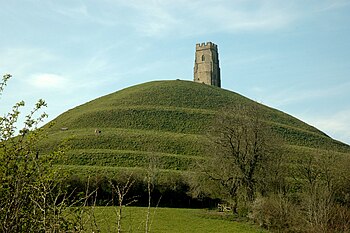Glastonbury Tor
Coordinates: 51 ° 8 ′ 41 ″ N , 2 ° 41 ′ 55 ″ W.
Glastonbury Tor (Celtic: Twr Avallach ; Tor means mountain, earth) is a 158 m high, teardrop-shaped hill in Glastonbury ( England ). Tor is a word of Celtic origin that means "conical hill". Due to the strategically favorable location, Celts temporarily settled on the gate. Later Romans occupied the hill. At the top is the restored 14th century tower of St Michael's Church. The gate is maintained by the National Trust for Places of Historic Interest or Natural Beauty .
Location and shape
The hill has a striking location in the middle of a plain, the Summerland Meadows , part of the Somerset Levels . The plain is reclaimed marshland from which the gate protrudes like an island, but actually forms a peninsula around which the river Brue flows on three sides.
The slopes of the gate look regularly terraced. Some believe that this shape is the remains of an ancient, perhaps Neolithic, sacred labyrinth , while others believe the terraces are natural furrows formed all over the grassy slopes by generations of grazing animals that will only slowly disappear unless the grass cover is destroyed .
history
Some Neolithic flint tools have been found on the top of the hill. In 1892 the remains of a village were discovered, which could be used to show that a Celtic settlement as early as 300 to 200 BC. Took place. There is evidence of wooden huts as early as Celtic times. At that time the plain was flooded, the village was an easily defended island in the moor (at low tide the island became a peninsula). Earthworks and Roman remains attest to a later occupation. The gate's Celtic name was Ynis Witrin , which means " glass island". By the British these spots seem Ynys yr Afalon to have been named, perhaps the Avalon of Arthurian legend .
Remains of a fortress from the 5th century were found on the gate. This was replaced by the medieval church of St. Michael's, which stood there until 1275. A second church, built in the 1360s, only stood until the dissolution of the English monasteries in 1539. The ruins of St. Michael's tower have been restored in modern times.
A replica was part of the opening ceremony of the 2012 Summer Olympics in London. Among other things, the flags of the participating nations were placed on the hill.
mythology
In Celtic mythology , the gate was associated with Gwynn fab Nudd , the supreme lord of the underworld and later king of the fairy people of the Tylwyth Teg . The gate was believed to be the entrance to Annwn or Avalon , the land of fairies. The mystical significance of the place continued in the Middle Ages when an annual Tor Fair was celebrated here . Later, the gate, 5th century fortifications and the name Avalon were associated with the legendary King Arthur .
geology
The gate was fed by the ferrous waters of the Chalice Well , a spring that existed for millions of years, which impregnated the sandstone all around with iron oxides and also increased the altitude. As the surrounding soft sandstone slowly eroded, Glastonbury Tor had taken shape.
See also
Web links
Individual evidence
- ^ Britain fires up the world: London gets the 2012 Games under way with the Greatest Show On Earth (rounded off by Macca, of course) . In: Mail Online , July 27, 2012. Retrieved July 28, 2012.

